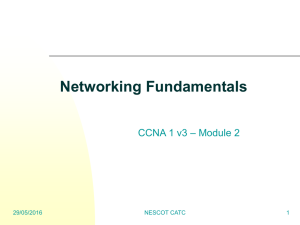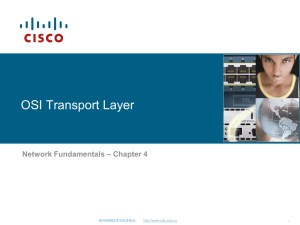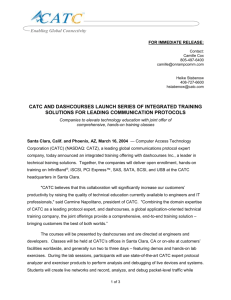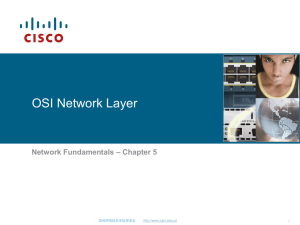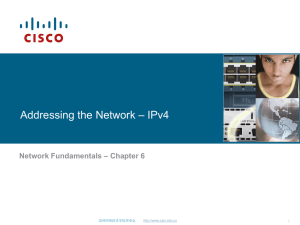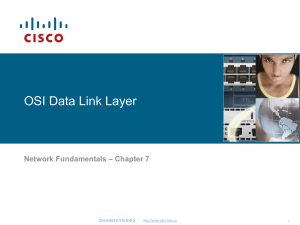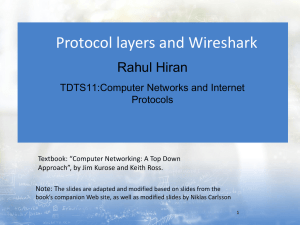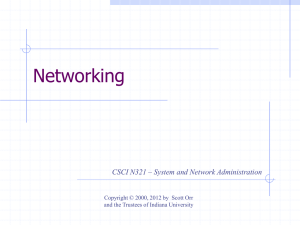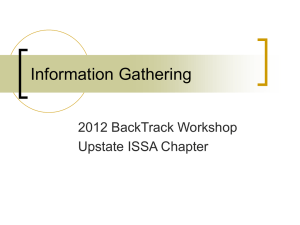3.3.1 DNS Services and Protocol
advertisement
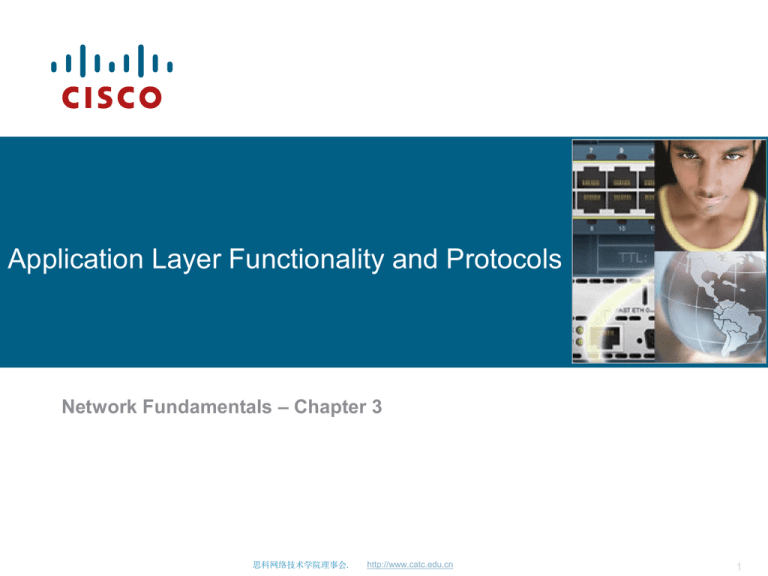
Application Layer Functionality and Protocols Network Fundamentals – Chapter 3 思科网络技术学院理事会. http://www.catc.edu.cn 1 Objectives Define the application layer as the source and destination of data for communication across networks. Explain the role of protocols in supporting communication between server and client processes. Describe the features, operation, and use of well-known TCP/IP application layer services (HTTP, DNS, SMTP). 思科网络技术学院理事会. http://www.catc.edu.cn 2 Context Index 3.1 Applications - The Interface Between the Networks 3.2 Making Provisions for Applications and Services 3.3 Application Layer Protocols and Services Examples 思科网络技术学院理事会. http://www.catc.edu.cn 3 3.1 Applications - The Interface Between the Networks 思科网络技术学院理事会. http://www.catc.edu.cn 4 Applications – The Interface Between Human and Data Networks it is important to know how an application is able to format, transmit and interpret messages that are sent and received across the network 思科网络技术学院理事会. http://www.catc.edu.cn 5 3.1.1 OSI and TCP/IP Model The OSI model divides the networking process into seven logical layers, each of which has unique functionality and to which are assigned specific services and protocols. 思科网络技术学院理事会. http://www.catc.edu.cn 6 3.1.1 OSI and TCP/IP Model Role of applications, services and protocols in converting communication to data that can be transferred across the data network. 思科网络技术学院理事会. http://www.catc.edu.cn 7 3.1.1 OSI and TCP/IP Model TCP/IP application layer protocols fit roughly into the framework of the top three layers of the OSI model: Application, Presentation and Session layers. 思科网络技术学院理事会. http://www.catc.edu.cn 8 3.1.1 OSI and TCP/IP Model The most widely-known TCP/IP Application layer protocols are those that provide for the exchange of user information. 思科网络技术学院理事会. http://www.catc.edu.cn 9 3.1.2 Application Layer Software< The functions associated with the Application layer protocols enable our human network to interface with the underlying data network. 思科网络技术学院理事会. http://www.catc.edu.cn 10 3.1.3 User Applications, Services, and Application Layer Protocols As mentioned previously, the Application layer uses protocols that are implemented within applications and services. 思科网络技术学院理事会. http://www.catc.edu.cn 11 3.1.4 Application Layer Protocol Functions Application layer protocols provide the rules for communication between applications. 思科网络技术学院理事会. http://www.catc.edu.cn 12 3.2 Making Provisions for Applications and Services 思科网络技术学院理事会. http://www.catc.edu.cn 13 3.2.1 The Client-Sever Model In the client/server model, the device requesting the information is called a client and the device responding to the request is called a server. 思科网络技术学院理事会. http://www.catc.edu.cn 14 3.2.2 Servers Servers are repositories of information. Processes control the delivery of files to clients. 思科网络技术学院理事会. http://www.catc.edu.cn 15 3.2.3 Application Layer Services and Protocols Server processes may support multiple clients. 思科网络技术学院理事会. http://www.catc.edu.cn 16 3.2.4 Peer-to-Peer Networking and Applications (p2p) In a peer-to-peer network, two or more computers are connected via a network and can share resources (such as printers and files) without having a dedicated server. 思科网络技术学院理事会. http://www.catc.edu.cn 17 3.2.4 Peer-to-Peer Networking and Applications (p2p) A peer-to-peer application (P2P), unlike a peer-to-peer network, allows a device to act as both a client and a server within the same communication. 思科网络技术学院理事会. http://www.catc.edu.cn 18 3.3 Application Layer Protocols and Services Examples 思科网络技术学院理事会. http://www.catc.edu.cn 19 3.3.1 DNS Services and Protocol Most people have a hard time remembering numeric IP address. Hence, domain names were created to convert the numeric address into a simple, recognizable name. 思科网络技术学院理事会. http://www.catc.edu.cn 20 3.3.1 DNS Services and Protocol Computer operating systems also have a utility called nslookup that allows the user to manually query the name servers to resolve a given host name. 思科网络技术学院理事会. http://www.catc.edu.cn 21 3.3.1 DNS Services and Protocol The DNS server stores different types of resource records used to resolve names. These records contain the name, address, and type of record. 思科网络技术学院理事会. http://www.catc.edu.cn 22 3.3.1 DNS Services and Protocol A hierarchy of DNS servers contains the resource records that match names with addresses. 思科网络技术学院理事会. http://www.catc.edu.cn 23 3.3.2 WWW Service and HTTP When a web address (or URL) is typed into a web browser, the web browser establishes a connection to the web service running on the server using the HTTP protocol. 思科网络技术学院理事会. http://www.catc.edu.cn 24 3.3.2 WWW Service and HTTP In response to the request, the HTTP server returns code for a web page. 思科网络技术学院理事会. http://www.catc.edu.cn 25 3.3.2 WWW Service and HTTP The browser interprets the HTML code and displays a web page. 思科网络技术学院理事会. http://www.catc.edu.cn 26 3.3.2 WWW Service and HTTP Entering ‘http://www.cisco.com’ in the address bar of a web browser generates the HTTP ‘GET’ Message. 思科网络技术学院理事会. http://www.catc.edu.cn 27 3.3.3 E-mail Services and SMTP/POP Protocols Clients send e-mails to a server using SMTP and receive e-mails using POP3. 思科网络技术学院理事会. http://www.catc.edu.cn 28 3.3.3 E-mail Services and SMTP/POP Protocols E-mail Server – MTA The mail Transfer Agent process governs e-mail handling between servers and servers. 思科网络技术学院理事会. http://www.catc.edu.cn 29 3.3.3 E-mail Services and SMTP/POP Protocols E-mail Server – MDA The mail Delivery Agent process governs delivery of email between servers and clients. 思科网络技术学院理事会. http://www.catc.edu.cn 30 3.3.3 E-mail Services and SMTP/POP Protocols SMTP is used to forward e-mail. POP is used to deliver e-mail. 思科网络技术学院理事会. http://www.catc.edu.cn 31 3.3.4 FTP FTP was developed to allow for file transfers between a client and a server. 思科网络技术学院理事会. http://www.catc.edu.cn 32 3.3.5 DHCP The Dynamic Host Confirmation Protocol (DHCP) service enables devices on a network to obtain IP addresses and other information from a DHCP server. 思科网络技术学院理事会. http://www.catc.edu.cn 33 3.3.5 DHCP The DHCP server maintains a pool of IP addresses and leases an address to any DHCP-enabled client when the client is powered on. 思科网络技术学院理事会. http://www.catc.edu.cn 34 3.3.6 File Sharing Services and SMB Protocol SMB is a client-server, request-response protocol. Servers can make their resources available to clients on the network. 思科网络技术学院理事会. http://www.catc.edu.cn 35 3.3.6 File Sharing Services and SMB Protocol A file may be copied from PC to PC with Windows Explorer using the SMB protocol. 思科网络技术学院理事会. http://www.catc.edu.cn 36 3.3.7 P2P Services and Gnutella Protocol With P2P applications based on the Gnutella protocol, people can make files on their hard disks available to others for downloading. 思科网络技术学院理事会. http://www.catc.edu.cn 37 3.3.7 P2P Services and Gnutella Protocol Many P2P applications do not use a central database to record all the files available on the peers. 思科网络技术学院理事会. http://www.catc.edu.cn 38 3.3.8 Telnet Services and Protocol Telnet provides a way to use a computer, connected via the network, to access a network device as if the keyboard and monitor were directly connected to the device. 思科网络技术学院理事会. http://www.catc.edu.cn 39 3.3.8 Telnet Services and Protocol Telnet is a client/server protocol and it specifies how a VTY session is established and terminated. 思科网络技术学院理事会. http://www.catc.edu.cn 40 Summary 思科网络技术学院理事会. http://www.catc.edu.cn 41 思科网络技术学院理事会. http://www.catc.edu.cn 42
